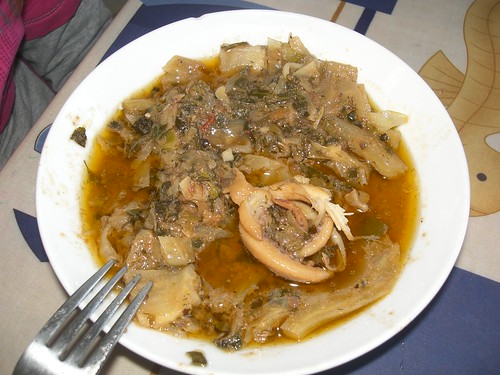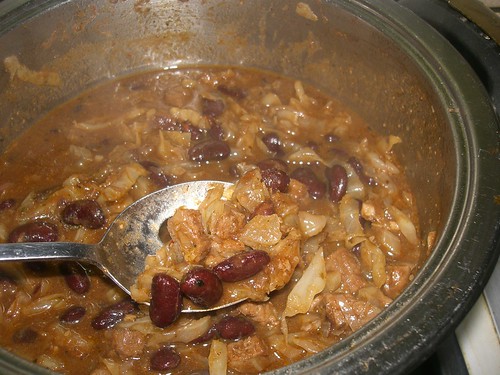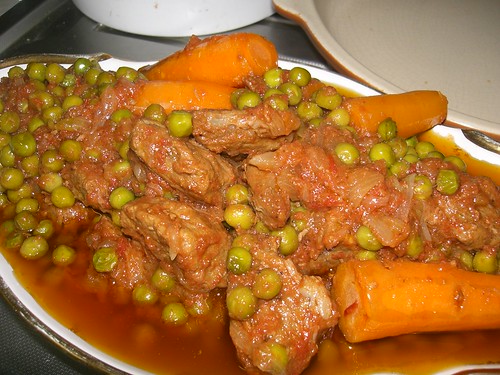One of our more memorable meals in London was taken on New Year's Eve at the Battersea Pie Station in Covent Garden. We had ended up there after attempting a walk along the Thames, starting from Cannon St. At Blackfriars, we were stopped by the crowd and safety control units who were policing the area and keeping people away from the riverside, due to the fireworks event that was schedule to take place later in the evening. Our detour away from the riverside took us through some very London sites of great historical interest. It almost felt Dickensian.

Poultry obviously takes its name from its former association with the chicken trade.

We were intrigued by what looked like a private function with a focus on seafood...

... and highly unamused by this vile-sounding Christmas food special! (It has been described as: "An overwhelmingly negative reaction, ranging from 'aggressively disgusting' to 'one of the worst things I’ve ever put in my mouth'. It gets points for effort, attempting to combine virtually every festive ingredient, but it tastes like someone has pushed their Christmas leftovers into a blender and served them with rice.")
New Year's Eve is a very quiet day for London business people, but even when London is supposedly sleeping...

... it keeps changing looks, as it prepares for various events, and this time, the portaloos made it look like it would be welcoming the New Year with a heavy bout of drinking.

We eventually needed to use a bathroom ourselves, so I popped into a Pret-a-Manger and bought some Christmas mince pies which I'd really wanted to try while in London.

When I asked for the bathroom facilities, believe it or not, this place did NOT have toilets! So we held off, in the hope that we would eventually find a place to take a leak legally.

At The Strand, the former Aldwych tube station, often used as a film location, looked ghostly silent. This street was cut off to strollers due to the fireworks event.

Somerset House was looking very festive with its ice rink (where we found some free bathroom facilities).

I had a quick browse through the ridiculously overpriced Fortnum and Masons shop (it was sponsoring the ice rink) - 50 pounds for a set of 6 Christmas crackers, did I read that right?!

A short stroll away, we found ourselves at Covent Garden. Cold weather makes you feel hungry all the time. I chose the Battersea Pie Station, in the hope that I would find some steak and kidney pie (and Cornish pasty - another of my favorite pies in New Zealand). We weren't disappointed. My family lets me do the ordering most places when in London, because they know I know the food well enough. My early life in colonial New Zealand stopped abruptly just when New Zealand's food tastes became more international, so I still have fond memories of New Zealand old-fashioned comfort food, which were invariably British-based.
Back home, when I decided to make a steak kidney pie myself, I found it near impossible to find kidneys! In Greece, the sale of beef and chicken kidneys has been banned since the mad cow furore - which started in the UK; yet, they aren't banned there! Although lamb's kidneys are still available for purchase here, when I tried to track some down, I found that they are never severed from the actual animal, so you have to buy the part of the animal that they are connected to. This is done for transparency reasons: in this way, the butcher is showing you that the animal was healthy - if the kidney is missing, the buyer may wonder whether the animal was sick.



To replace the umami taste of the kidneys, I bought a packet containing two slices of kavurma, adding some mushrooms and soya sauce (I was out of Worcestershire sauce) to my beef stew. I think the taste was successful, and the whole family enjoyed the pie, which will be made again eventually, because I froze half the stew. Slow-cooked food takes a long time to cook, so why not make a double batch and save your time later?
Bonus photo: A chat with the butcher where I bought the beef also revealed another mysterious EU meat regulation, which forbids lamb's spleen from being sold - but cow's spleen is permissible!

At any rate, if you have close relations with someone who raises their own meat, you can procure everything. I had lamb's spleen in sheep's intestine last week at an inner-city cafe bar, where the landlord-owner-cook prepares everything freshly and to order.
©All Rights Reserved/Organically cooked. No part of this blog may be reproduced and/or copied by any means without prior consent from Maria Verivaki.

Poultry obviously takes its name from its former association with the chicken trade.

We were intrigued by what looked like a private function with a focus on seafood...

... and highly unamused by this vile-sounding Christmas food special! (It has been described as: "An overwhelmingly negative reaction, ranging from 'aggressively disgusting' to 'one of the worst things I’ve ever put in my mouth'. It gets points for effort, attempting to combine virtually every festive ingredient, but it tastes like someone has pushed their Christmas leftovers into a blender and served them with rice.")
New Year's Eve is a very quiet day for London business people, but even when London is supposedly sleeping...

... it keeps changing looks, as it prepares for various events, and this time, the portaloos made it look like it would be welcoming the New Year with a heavy bout of drinking.

We eventually needed to use a bathroom ourselves, so I popped into a Pret-a-Manger and bought some Christmas mince pies which I'd really wanted to try while in London.

When I asked for the bathroom facilities, believe it or not, this place did NOT have toilets! So we held off, in the hope that we would eventually find a place to take a leak legally.

At The Strand, the former Aldwych tube station, often used as a film location, looked ghostly silent. This street was cut off to strollers due to the fireworks event.

Somerset House was looking very festive with its ice rink (where we found some free bathroom facilities).

I had a quick browse through the ridiculously overpriced Fortnum and Masons shop (it was sponsoring the ice rink) - 50 pounds for a set of 6 Christmas crackers, did I read that right?!

A short stroll away, we found ourselves at Covent Garden. Cold weather makes you feel hungry all the time. I chose the Battersea Pie Station, in the hope that I would find some steak and kidney pie (and Cornish pasty - another of my favorite pies in New Zealand). We weren't disappointed. My family lets me do the ordering most places when in London, because they know I know the food well enough. My early life in colonial New Zealand stopped abruptly just when New Zealand's food tastes became more international, so I still have fond memories of New Zealand old-fashioned comfort food, which were invariably British-based.
 |
| Chicken and mushroom pie, steak and kidney pie, and Cornish pasty - ~20 pounds, with a bottle of beer and a cup of tea. |


I used this very easy-to-follow recipe as the basis of my beef stew and pastry. The beef stew was cooked last night, the pastry was made this morning, and we had the pie for lunch with some leek and potato soup.

To replace the umami taste of the kidneys, I bought a packet containing two slices of kavurma, adding some mushrooms and soya sauce (I was out of Worcestershire sauce) to my beef stew. I think the taste was successful, and the whole family enjoyed the pie, which will be made again eventually, because I froze half the stew. Slow-cooked food takes a long time to cook, so why not make a double batch and save your time later?
Bonus photo: A chat with the butcher where I bought the beef also revealed another mysterious EU meat regulation, which forbids lamb's spleen from being sold - but cow's spleen is permissible!

At any rate, if you have close relations with someone who raises their own meat, you can procure everything. I had lamb's spleen in sheep's intestine last week at an inner-city cafe bar, where the landlord-owner-cook prepares everything freshly and to order.
©All Rights Reserved/Organically cooked. No part of this blog may be reproduced and/or copied by any means without prior consent from Maria Verivaki.




















































